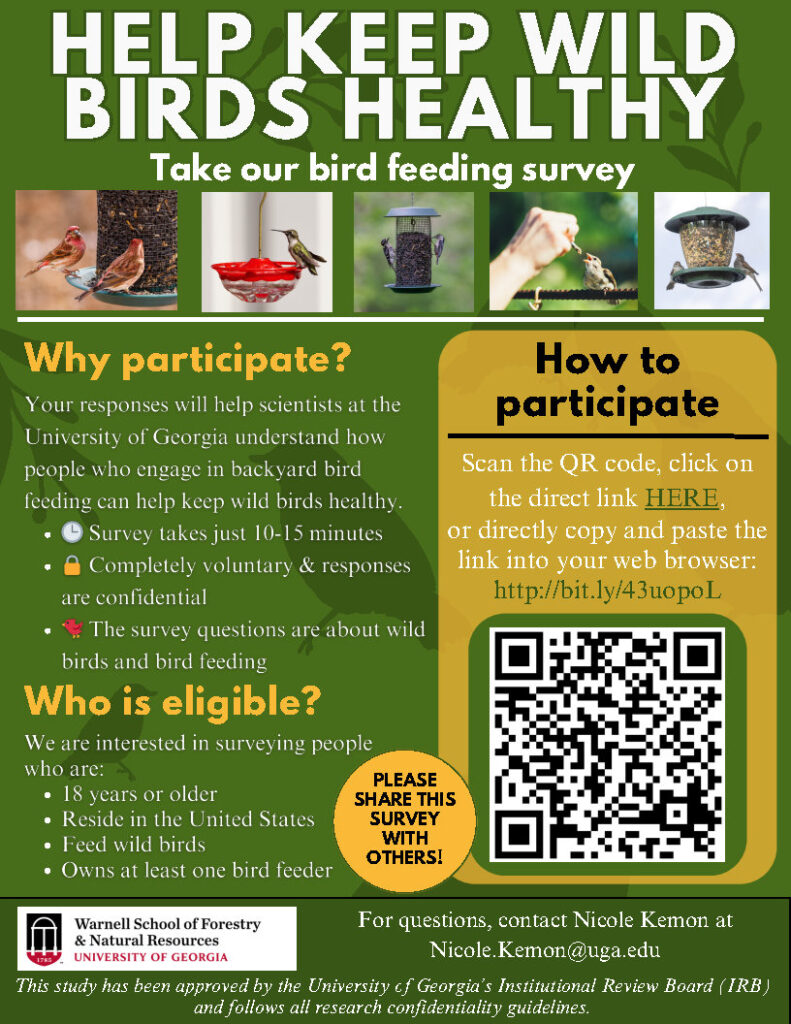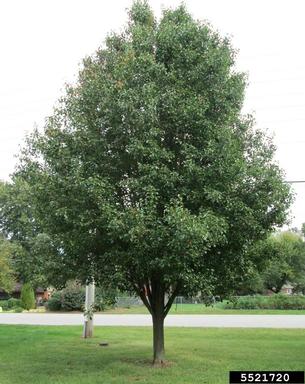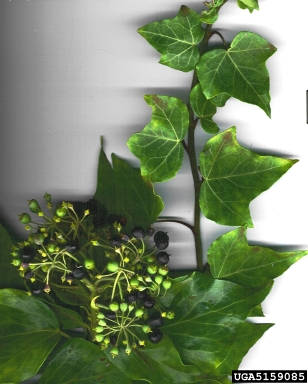
Table of Contents
Clean feeders save birds
Article by Georgia DNR:
During spring and summer, sick birds are occasionally reported in backyards across the state. A common denominator in these incidents is feeders and feeding areas that have not been cleaned regularly. Continue reading clean feeders save birds article
Help keep wild birds healthy survey

“Do you feed wild birds with a bird feeder? Scientists at the University of Georgia are conducting a research study to learn more about people’s bird feeding behaviors and how they help protect wild bird health. We invite you to take a short 10–15-minute survey. Your responses will help scientists better understand how we can support healthy bird populations.
Why participate? — Your responses will help scientists at the University of Georgia understand how people who engage in backyard bird feeding can help keep wild birds heathy. The survey takes just 10-15 minutes; completely voluntary & responses are confiential; survey questions are about wild birds and bird feeding.
Who is eligible? — We are interested in surveying people who are: 18 years or older; reside in the US; feed wild birds; owns at least one bird feeder.
For Questions, contact Nicole Kemon at Nicole.Kemon@uga.edu. – This study has been approved by the UGA Institutional Review Board and follows all research confidentiality guidelines.
Healthy wild birds survey link
Florida Master Naturalist Program Opportunity – Invasive Plants of Florida

University of Florida IFAS Extension Nassau County teaches Florida Master Naturalist Program! This year, the Land Steward Course, Invasive Plants of Florida will be offered September 16-19, 2025 at the American Beach Community Center (1600 Julia St, Fernandina, FL). This is an in-Person, 4-day course which includes: 24 teaching hours; guest speakers; field trips; course textbook. The cost is $250 or $295 (with printed and bound color manual). Follow the link below to add your name to the interest list. Once the class registration is available, an email will be sent with detailed information.
FL Master Naturalist Program Interest Form
Invasive Species Alert!
Chinese Privet (Ligustrum sinense)

Photo credit: Karan A. Rawlins, University of Georgia, Bugwood.org
Leaves are opposite, oblong, and bottom side midvein is slightly hairy
Flowers in spring-summer at branch tips; small, white with four petals, and long stamens
Fruit dull, waxy, purple-black berries in bunches that last through winter
Additional Chinese Privet Info
Invasive Species Tips: Fruit and seeds of invasive ornamentals can travel far beyond your property and cause invasions where they have not been planted.
If you can’t remove the invasive plants from you landscape, you can remove the fruit!
This can help prevent the spread of the invasive species by wildlife and other means.
Callery Pear (Pyrus calleryana)

Photo Credit: David Stephens, Bugwood.org
Overview:
Callery pear is also known by one of its variety names, Bradford pear. It is an invasive tree that is native to Asia and was introduced as root stock for improvement of edible pears and then later as an ornamental. It is now spread broadly throughout the eastern US along with about 20 other cultivars. It must have pears of another cultivar to produce fertile fruit, which were introduced to provide sturdier trees. Tree invading the whole US, flowering eary spring; small brown fruit in clusters.
Appearance:
A round to pyramidal-shaped deciduous tree that can grow up to 60 ft (18 m) tall and 2 ft. (0.6 m) diameter. Branches and twigs will often have thorns.
Foliage is dark green, oval to nearly heart-shaped, alternate, simple, 2-3 in (5.1-7.6 cm) long, and shiny with wavy, slightly toothed margins. It has attractive autumn colors.
Flowers grow in bunches in spring, often before leaves appear. They are 1 in (2.5 cm) wide, showy, malodorous, and white. Fruit are round, 0.3-0.5 in (0.8-1.3 cm) in diameter, and hard until a frost occurs; softened fruit are eaten by birds and spread widely.
More Info
Branch unions are often weak and break in high wind or from heavy ice or snow and either cause a slow death by infection or catastrophic failure.
Callery Pear Species Info
Native Alternative to Callery (Bradford) pear: Eastern redbud (Cercis canadensis)
Tolerant of urban condiditons; showy flowers; small size; many cultivars available
True Value of Redbud Trees – GA DNR
English Ivy (Hedera helix)

Photo credit: Forest and Kim Starr, Starr Environmental, Bugwood.org
Appearance:
Hedera helix is an evergreen perennial climbing vine that attaches to bark of trees, brickwork and other surfaces by root-like structures that exude a glue-like substance to aid in adherence.
Foliage:
Leaves are alternate, dark green, waxy, somewhat leathery; extremely variable leaf forms, from unlobed to 3-5 lobed; typically green with whitish veins.
Flowers:
Flowering occurs in late summer to early fall, typically under full sun conditions; flowers are small, greenish-yellow and occur in globular starburst type inflorescence at tips of flowering stems.
Fruit:
Fruits are black with a fleshy outer layer and stone-like seeds. New plants grow easily from cuttings or stem fragments that make contact with the soil.
Ecological Threat:
Hedera helix is an aggressive invader threatening all levels of forested and open areas, growing along the ground as well as into the forest canopy. Vines climb up tree trunks and envelop branches and twigs, blocking sunlight from the host tree’s foliage, impeding photosynthesis. An infested tree will exhibit decline for years before it dies. The weight of vines also makes trees susceptible to blowing over in storms. This plant has been confirmed as a reservoir for bacterial leaf scorch (Xylella fastidiosa), which affects a wide variety of trees.
Additional English Ivy Information
Alternatives to plant instead of English Ivy:
crossvine (Bignonia capreolata) – Native to central and southern US; Perennial vine; Evergreen in the sout; Blooms in summer; Can be vigorous to weedy, depending on the situation.
Canadian wildginger (Asarum canadense) – Native to eastern US; Perennial, forms dense colonies; Persistent leaves, but not evergreen; Spreads by rhizomes; Deer resistant
Report Invasive Species Sightings: Reporting, maps, and more on invasive, pest, and biocontrol species